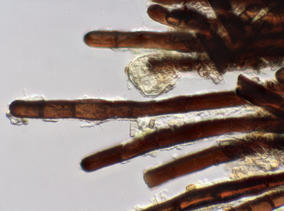You are here
All Fungi
Helminthosporium microsorum
Nomenclature
-
Family: MassarinaceaeGenus: Helminthosporium
SUMMARY
Anamorph: colonies punctiform, black, hairy, usually in patches. Mycelium immersed, growing in aborted stromata or conidiomata of Coryneum below the periderm. Conidiophores (95–) 160–380 (–560) μm long, (11.5–) 12.5–16 (–17) diam. at the base, (9–) 10–12 (–13.5) μm diam. near the apex, fasciculate, arising from upper cells of the stromata, simple, flexuous, cylindrical, dark brown, smooth-walled, septate, with a pore at the apex and often 1–2 lateral pores beneath the upper 1–2 septa. Conidia (85–) 90–120 (–140) × (16–) 17–20 (–22) μm, tapering to 5–9 μm at the distal end, with a 5–7.5 μm diam. blackish-brown to black scar at the base, arising terminally and sometimes laterally through pores or thin areas in the conidiophore wall, obclavate, pale to golden brown, smooth-walled, 7–11 (–17)-distoseptate, with angular lumina; wall to 5.5 μm thick.
Teleomorph: Stromata formed in the upper bark, well-developed, dark reddish brown, pseudoparenchymatous, of thick-walled dark brown cells, with a margin composed of dark brown, coarsely verrucose hyphae. Ascomata immersed in stromata, distinctly elevating the bark, singly or sometimes in small groups, 420–700 μm diam. and 130–320 μm high, strongly depressed, entirely filled by pure white hymenial tissue. Peridium 15–25 (–30) μm thick, composed of pale to medium angular brown cells. Ostioles central, (85–) 120–230 (–260) μm long, 95–160 (–180) μm diam. Interascal tissue of filiform septate branched and anastomosing pseudoparaphyses 1.8–3.5 μm diam. Asci (150–) 170–200 (–220) × (36–) 39–47 (–49) μm, clavate, 8-spored. Ascospores irregularly biseriate, (35–) 43–61 (–86) × (16–) 18–21.5 (–25.5) μm, hyaline to subhyaline, turning light to medium brown at full maturity, dark brown after ejection, ± ellipsoidal to obovoid, rarely fusiform, asymmetric, 1-septate, with few to numerous ring-like thickenings of the inner wall giving it an irregularly wavy outline, at full maturity sometimes developing into thin transverse distosepta, strongly constricted at the ± median primary septum, with usually rounded, rarely subacute end cells, smooth-walled, the contents granular, sometimes with a large and several smaller guttules per cell; each hemisphere surrounded by a thick gelatinous sheath.






